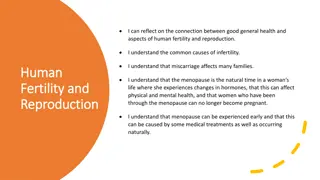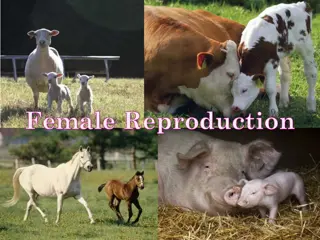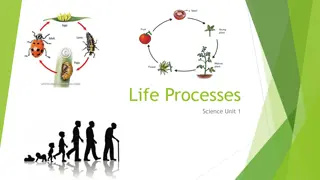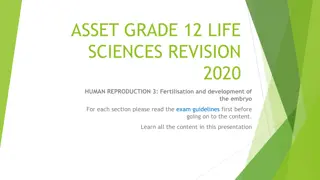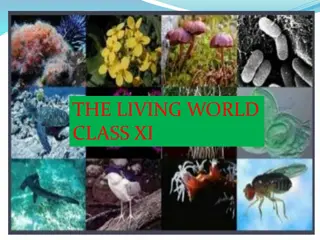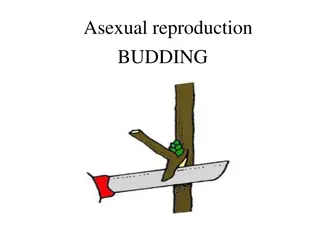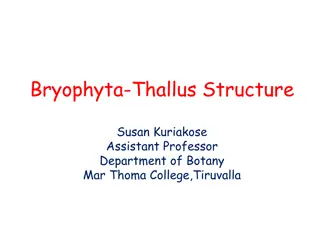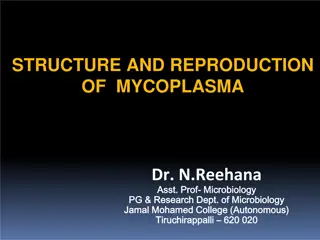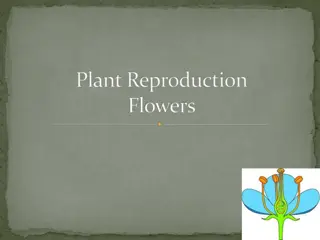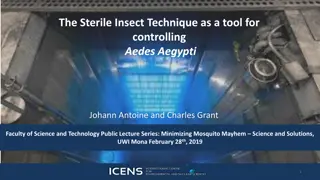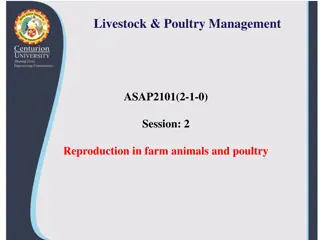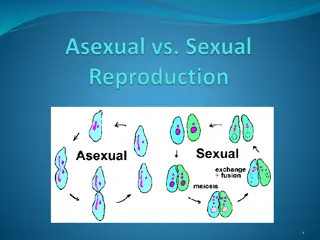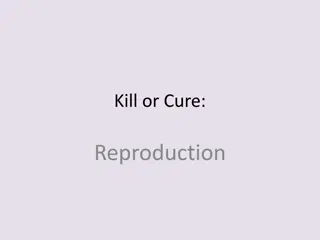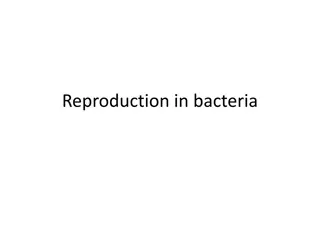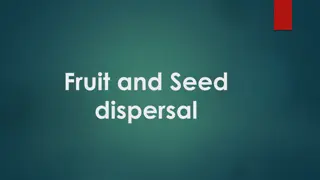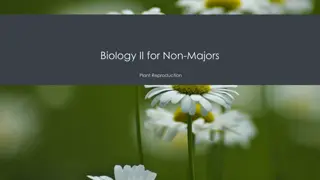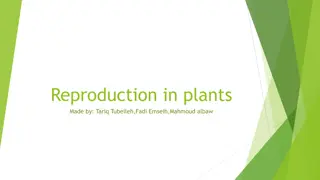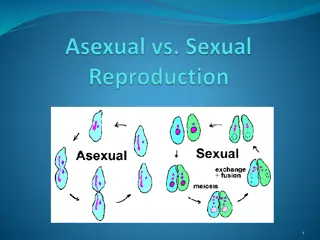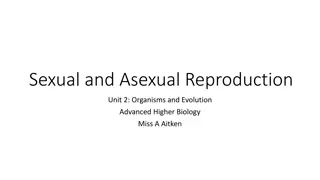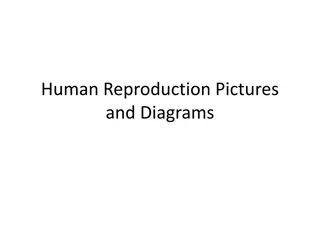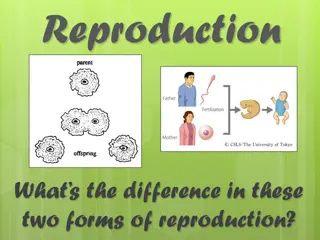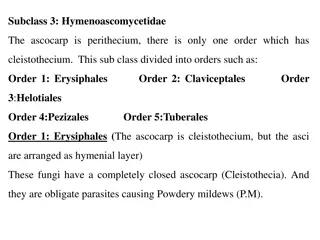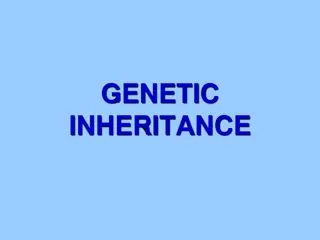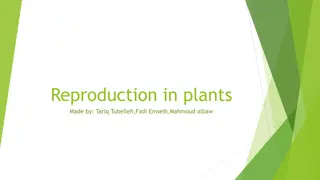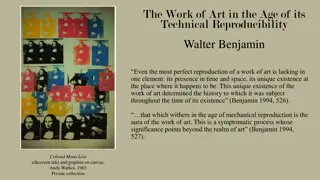Guide to Efficient Rodent Breeding and Colony Management
This comprehensive guide covers essential aspects of rodent breeding, colony management, and tips for successful rodent reproduction. It includes details on weaning, retiring breeders, records management, problem-solving, resources, goals and planning, breeding systems, reproduction processes, genot
4 views • 35 slides
Understanding Cell Reproduction and the Cell Cycle
Explore the process of cell reproduction, DNA structure, chromosomes, and the differences between prokaryotic and eukaryotic cell cycles. Learn about binary fission, mitosis, and cytokinesis in the context of cellular growth and division. Understand the significance of genes, DNA organization into c
5 views • 56 slides
Exploring Seed Plant Diversity and Adaptations
Delve into the realm of seed plants, uncovering their unique adaptations for reproduction, their phylogeny with gymnosperms and angiosperms, and the diversity within gymnosperms such as conifers, cycads, gingkophytes, and gnetophytes. Discover the evolutionary success of seed plants through their wa
5 views • 23 slides
Understanding Human Fertility, Reproduction, and Miscarriage
Explore the complexities of human fertility, reproduction, and the emotional impact of miscarriage. Learn about pregnancy, infertility, menopause, and the dynamics of conception. Gain insights into the causes of infertility, the process of reproduction, and the prevalence of miscarriages at differen
2 views • 13 slides
Understanding Female Reproduction System
The female reproduction system plays a crucial role in producing fertile eggs, hormones, and facilitating fertilization, pregnancy, and birth. Key terms like estrous and estrus, ovulation, and folliculogenesis are essential to grasp. The female reproductive tract consists of tubular organs like the
0 views • 27 slides
Understanding the Seven Life Processes in Science
Explore the fascinating world of life processes through topics such as characteristics of life, movement, photosynthesis, reproduction, and sensitivity. Delve into the functions that define living organisms and learn how plants and animals sustain life through energy release, growth, and reproductio
3 views • 19 slides
Understanding Reproduction: Pollen, Eggs, and Life Cycles in Plants
Reproduction in plants involves the transfer of pollen to eggs, leading to fertilization and the formation of new life. Male animals produce sperm, while females produce eggs, which fertilize when they meet. Different animals exhibit external or internal fertilization, with varying numbers of offspr
1 views • 13 slides
Human Reproduction: Fertilisation and Embryo Development Overview
Human reproduction involves the complex processes of fertilisation and embryo development. Fertilisation occurs when the nucleus of a sperm cell fuses with the nucleus of an ovum to form a zygote. The zygote undergoes mitosis to develop into a blastocyst, which then implants into the endometrium. Th
0 views • 12 slides
Understanding the Characteristics of Living Organisms
Life is a unique biochemical process expressed through chemical reactions leading to growth, development, responsiveness, adaptation, and reproduction. Living organisms exhibit characteristics such as growth, definite shape and size, reproduction, metabolism, and cellular organization. These traits
4 views • 32 slides
Understanding Asexual Reproduction Through Budding
Budding is a form of asexual reproduction where scion (bud) and rootstock are connected to grow as one plant. Different types of budding methods include Shield/T budding, Patch budding, Chip budding, Ring budding, and more. Each method involves specific techniques and is commonly used in horticultur
1 views • 24 slides
Bryophyta Thallus Structure and Reproduction in Hepaticopsida
The Bryophyta group includes structures like thalli and reproductive organs, particularly in the class Hepaticopsida. These plants have simple or foliose body structures with distinct characteristics such as aseptate rhizoids, ventral scales, and chloroplasts without pyrenoids. The gametophyte is st
1 views • 20 slides
Mycoplasma: Structure, Reproduction, and Characteristics
Detailed exploration of Mycoplasma covering its structure, reproduction, and general characteristics. Discusses the ultrastructure, species like Mycoplasma pneumonia and Mycoplasma hominis, and their unique traits such as lack of cell wall, pleomorphism, and reproduction methods. The article also to
0 views • 14 slides
Understanding Plant Reproduction through Flowers
Explore the intricate process of plant reproduction through flowers, including the functions of various flower parts, the types of flowers (perfect vs. imperfect), the significance of pollination, and the different pollination vectors involved in ensuring successful reproduction in plants.
0 views • 12 slides
Utilizing Sterile Insect Technique for Aedes Aegypti Control
The Sterile Insect Technique (SIT) is a biologically-based method used to manage key insect pests by releasing sterile insects to decrease population reproduction. This technique, developed through genetic manipulation and ionizing radiation, has been instrumental in controlling insect populations l
0 views • 13 slides
Understanding Reproduction in Livestock and Poultry Management
This course delves into the intricate processes of reproduction in farm animals and poultry, covering stages like proestrus, estrus, metestrus, diestrus, and anestrus. It explores the roles of hormones like testosterone, estrogen, progesterone, relaxin, and oxytocin in regulating reproductive functi
0 views • 51 slides
Understanding Asexual Reproduction in Organisms
Asexual reproduction requires only one parent, resulting in offspring that are exact clones of the parent, with the same DNA and chromosomes. This method is common in one-celled organisms and involves processes like binary fission, plant cuttings, budding, fragmentation, and regeneration. Various or
2 views • 13 slides
Reproduction in Organisms: Overview and Types
Understanding the concept of reproduction in organisms, this content delves into the different modes of reproduction such as asexual and sexual, with examples and illustrations. It covers the life spans of various organisms and details various methods of asexual reproduction like fission, budding, s
0 views • 23 slides
General Characteristics of Phycomycetes in Fungi Classes
Fungi are classified into four classes based on hyphae, spores, and reproduction methods. Phycomycetes, as an algal-like fungi class, showcase varied forms with reproduction mainly through sexual or asexual means. The thallus structure varies from one-celled to well-branched mycelium, and reproducti
0 views • 22 slides
Understanding Different Types of Reproduction in Organisms
Unwanted materials can be passed directly or indirectly, impacting the complexity of systems and bodies. Reproduction methods include sexual and asexual, each with unique processes and characteristics. Asexual reproduction involves division and growth, while sexual reproduction combines hereditary i
1 views • 105 slides
Reproduction: Exploring the Intersection of Science and Society
This module delves into the theme of reproduction and reproductive health, highlighting its dual nature as a scientific and social issue. It covers aspects like maternity, fertility control, and assisted reproduction, emphasizing the importance of reproductive health for overall well-being. The evol
0 views • 24 slides
Understanding Bacterial Reproduction: A Comprehensive Overview
Explore the various types of reproduction in bacteria, including asexual reproduction through binary fission, as well as the intricate process of endospore formation for survival in harsh conditions. Discover how bacterial cells exchange genetic material in sexual reproduction through conjugation, t
0 views • 19 slides
Understanding Reproduction in Living Organisms
Reproduction in living organisms involves both sexual and asexual methods, with each having unique processes. Sexual reproduction involves the fusion of genetic material from two individuals, while asexual reproduction results in genetically identical offspring. Different forms of plant reproduction
0 views • 14 slides
Understanding Algae: Classification, Habitat, and Reproduction
Algae are chlorophyllous thallophytes that thrive in aquatic environments, producing their own food and oxygen through photosynthesis. They are categorized based on habitat as aquatic, terrestrial, aerophytes, cryophytes, and thermophytes. The three main classifications of algae are Chlorophyceae (g
0 views • 16 slides
Understanding Reproductive Modes: Asexual vs. Sexual
Reproduction can occur through asexual or sexual means, each with its distinct processes and outcomes. Asexual reproduction involves only one parent and produces genetically identical offspring, while sexual reproduction involves the fusion of specialized sex cells from two parents to create genetic
1 views • 46 slides
Plant Reproduction: Pollination and Seed Dispersal Mechanisms
Explore the fascinating world of plant reproduction through pollination and seed dispersal mechanisms. Learn about the different types of pollination, such as self-pollination and cross-pollination, and the importance of fruit and seed dispersal. Discover how plants use various strategies to ensure
0 views • 6 slides
Plant Reproduction and Life Cycles in Biology II for Non-Majors
Explore the complex processes of plant reproduction, life cycles, and the alternation of generations in biology. From the fusion of male and female gametes to the development of sporophytes and gametophytes, delve into the stages and structures involved in the reproduction of gymnosperms and angiosp
0 views • 25 slides
Reproduction Methods: Asexual vs. Sexual Reproduction in Organisms
Asexual and sexual reproduction are two fundamental methods in nature, with asexual reproduction producing genetically identical offspring and sexual reproduction resulting in genetic variation. Asexual methods include fission, budding, fragmentation, and parthenogenesis, while sexual reproduction i
1 views • 6 slides
Understanding Reproduction in Plants: Types, Processes, and Examples
Reproduction in plants involves both sexual and asexual methods, each with distinct processes and outcomes. This article delves into the types of reproduction, including sexual and asexual processes, explaining their mechanisms, examples in plants, and the importance of pollination. It contrasts ase
0 views • 25 slides
Understanding Asexual Reproduction in Living Organisms
Explore the fascinating world of asexual reproduction in living organisms through informative images and descriptions covering various forms such as binary fission, budding, fragmentation, and regeneration. Learn how asexual reproduction differs from sexual reproduction and discover examples of orga
0 views • 15 slides
Understanding Reproduction: Sexual vs Asexual and the Paradox of Sex
Explore the benefits and drawbacks of sexual and asexual reproduction in organisms, why both forms exist, and the paradox of sex. While asexual reproduction offers efficiency and simplicity, sexual reproduction introduces genetic diversity and complexity. Discover how different species, including pr
0 views • 8 slides
Reproduction in Organisms: A Comparison of Sexual and Asexual Methods
Reproduction in organisms involves two main methods - sexual and asexual. In sexual reproduction, two parents contribute genetic information, leading to unique offspring, while asexual reproduction involves a single parent producing genetically identical offspring. This article explores the differen
0 views • 16 slides
Educational Human Reproduction Pictures and Diagrams
Detailed collection of human reproduction pictures and diagrams for educational purposes. Includes slides illustrating various stages and processes of human reproduction. Access additional resources through the provided website link.
0 views • 14 slides
Understanding Types of Reproduction in Organisms
Organisms reproduce through asexual and sexual reproduction methods. Asexual reproduction involves one parent and produces uniform offspring, like in binary fission, budding, and regeneration. Sexual reproduction involves two parents and results in offspring with varied traits. Both methods have the
0 views • 24 slides
Asexual Reproduction and Passing of Traits
Asexual reproduction involves cell division to create genetically identical offspring. This process includes binary fission, budding, fragmentation, and vegetative growth. Offspring produced through asexual reproduction inherit traits directly from the parent organism. Understanding asexual reproduc
1 views • 24 slides
Fungal Classification and Reproduction in Hymenoascomycetidae Subclass
Hymenoascomycetidae subclass includes orders like Erysiphales, Claviceptales, Helotiales, Pezizales, and Tuberales. Erysiphales fungi cause Powdery Mildews with closed ascocarps, while Claviceptales produce filamentous ascospores. Asexual reproduction involves conidiophores, while sexual reproductio
0 views • 8 slides
Understanding Genetic Inheritance and Reproduction
Delve into the world of genetic inheritance and reproduction through topics such as gametes, fertilization, allele definition, genotype versus phenotype, dominant versus recessive traits, and the process of sexual reproduction. Explore how genetic information is passed on from parents to offspring,
0 views • 41 slides
Understanding Plant Reproduction: Types, Processes, and Examples
Explore the fascinating world of plant reproduction through this comprehensive guide. Learn about sexual and asexual reproduction, their differences, and examples in plants. Discover the importance of pollination, the roles of plant parts, and the various methods of asexual reproduction in plants. E
0 views • 26 slides
Plant Classification and Reproduction Overview
Plants are categorized into four groups: Mosses, Ferns, Conifers, and Flowering Plants. Mosses reproduce by spores and lack roots or xylem vessels. Ferns reproduce via spores, while conifers reproduce with seeds found in cones and have needle-shaped leaves. Flowering plants reproduce using seeds fou
0 views • 8 slides
Impact of Islamic Beliefs on Reproduction among Syrian Refugees
This study explores how Islamic beliefs influence experiences of reproduction among Syrian refugees in Jordan, considering the intersection of religion, gender, and culture in the context of displacement and migration. It investigates how religiously-informed notions of kinship, motherhood, and gend
0 views • 23 slides
The Work of Art in the Age of Its Technical Reproducibility by Walter Benjamin
Walter Benjamin discusses the impact of technological reproduction on art, specifically the loss of aura through mechanical processes. He emphasizes the significance of art's unique existence in time and space, examining how modern art has evolved in response to new modes of reproduction. Benjamin's
0 views • 18 slides



